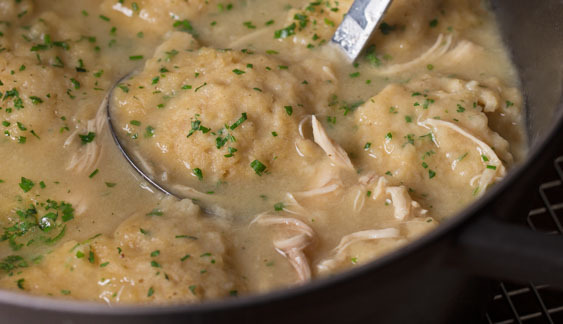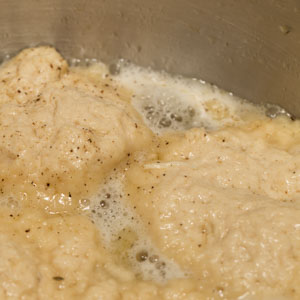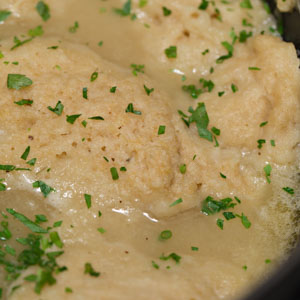Chicken and Dumplings

introduction
In the category “pre-execution last supper,” chicken and dumplings would come in second—right after cacio e pepe—on our request list. Second place is not too shabby in this equation, though thinking it over, prison chefs might execute the former with more finesse than the latter. In terms of life outside of prison, however, finding a plate of great pasta is considerably easier than finding a bowl of great chicken and dumplings. In fact, chicken and dumplings have become more a work of fiction than a work of art. Perhaps somewhere upon a twinkling Iowa farmhouse . . . but we don’t get out that way too often.
Let’s get right to the definition of great chicken and dumplings. By “dumplings,” we mean puffy poached biscuits, not rolled-out-and-cut strips known as slippery dumplins. Not that slippery dumplins aren’t great. In fact, a disagreement within the immediate family on which version to pursue was settled only when the bad wife with strident views and a German grandmother prevailed over the obliging husband with too much on his plate and a Southern grandmother. In the wife’s view, slippery dumplins share rather too much ancestry with German noodles. Whereas light, fluffy dumplings are pure poached-biscuit magic. The desired prototype would comprise a satiny perimeter with a touch of slip encircling a tender, baked-biscuit center. Two or three bites wide. Despite the fact that such dumplings use a pretty straight biscuit formula, the poaching requirement ratchets the whole biscuit-to-dumpling proposition up a notch or three. Unlike matzo balls, dumplings don’t have eggs for support, and we didn’t want to stuff them so full of flour they’d end up gut busters (the dish itself is filling enough!), so we worked around various proportions of cake flour and pastry flour to achieve lightness. We knew whatever combinations of flour we came up with would supply superb flavor and performance.
But wait, we’re getting ahead of ourselves, slighting the other two critical components of this dish: the chicken and the broth. The chicken is important, the broth more so. In fact, the entire achievement of this dish can be found in the perfect play between the chicken (not too much, not too chunky), the broth (must be first-rate and quite fortified), and the dumplings (must carry the flavor of superior wheat, butter, and chicken). We were fortunate to be able to get locally raised chickens we saw pecking around in a nearby field every day. This obviously makes an enormous difference. To pull chicken flavor into the dumplings themselves (forming a bridge between ingredients) we used fat skimmed from the broth—this fat carried fractions of the herbs and aromatics we’d used, plus unrivalled chicken essence, straight into to the dumplings. And we were content to restrict the broth aromatics to a potent but invisible presence in the dish itself—no vegetables fighting for space on the spoon. To keep the chicken itself from interrupting the dumplings’ performance, we shredded it and kept the ratio relatively low. The toughest challenge was achieving the correct ratio of flours so the dumplings cohered and poached properly while leaving a much appreciated trace of themselves behind in the broth to thicken it just so—not soup, not gravy.
These dumplings are a taste and texture extravagance—tender, silky, a swirl of simple, rich flavor and delicate bites. We burned our tongues more times than we care to remember. But it was worth it.
Cooking Remarks
Get a great chicken and don’t look back—that’s all we can say. The broth is the repository of all that’s vital to this dish. (You already have the flours.) And the dumplings themselves are so easy, it’s almost a sin. The thing to remember when poaching is that the broth must be frankly simmering when you begin dropping dumplings in the pot (dip the spoon in the hot broth between dumplings to minimize sticking)—the broth will cool down as they are dropped in, and the dumplings need that initial heat to help activate the leavening. Take care to cover the pot, and then get out of the way. The simmer should be gently persistent but not aggressive. Dumplings like this should have a pleasing irregularity in shape, so don’t despair when they lack matzo-ball uniformity.
equipment mise en place
For this recipe, you will need a heavy-bottomed 6-quart Dutch oven, a pair of tongs, a footed colander, a large bowl, a large fine-mesh sieve, a digital kitchen scale, a small saucepan, a medium bowl, a whisk, a dinner fork, and a soupspoon.
-
for the chicken and broth:
-
2medium yellow onions, peeled and chopped
-
2medium celery ribs, chopped
-
1carrot, peeled and chopped
-
10large garlic cloves, peeled and halved
-
6fresh thyme sprigs or 2 teaspoons dried thyme
-
A handful of fresh flat-leaf parsley sprigs
-
1Turkish bay leaf
-
20black peppercorns
-
1(4-pound) whole chicken
-
2quarts spring or filtered water
-
-
for the dumplings:
-
1ounce unsalted European-style butter
-
3.8ounces whole milk
-
Fine sea salt and freshly ground black pepper
-
4
-
2
-
2teaspoons baking powder
-
1tablespoon chopped fresh flat-leaf parsley
-
1tablespoon minced fresh chives
-
-
Day 1, cook the chicken and make the broth: In a heavy-bottomed 6-quart Dutch oven, combine the vegetables, garlic cloves, herbs, and peppercorns. Place the chicken breast side-up in the pot, pour in the water, and bring it to a simmer over medium-high heat. Reduce the heat to low, cover partially, and simmer for 35 minutes. Using a pair of tongs inserted in the cavity of the chicken, turn the chicken breast side down, cover the pot partially, and continue to simmer until the drumstick moves about loosely in the joint, 20 to 30 minutes more. Turn off the heat and use the tongs to transfer the chicken to a footed colander set in a large bowl. When the chicken is cool enough to handle, remove the meat from the bones and shred it with your fingers (fig. 1.1), leaving a fair bit of meat on the chicken so that the broth will be flavorful. Turn the shredded meat into a bowl, cover, and refrigerate until ready to use. Return the bones, skin, and any liquid in the bowl to the pot and bring the broth to a simmer over medium heat. Simmer until it is rich and flavorful and measures 5 cups, about 45 minutes. Strain the broth through a large fine-mesh sieve into the bowl; discard the solids in the sieve. Let the broth cool to room temperature, and then cover and refrigerate overnight.
-
Day 2, make the dumplings: Skim off and reserve the fat from the surface of the broth (fig. 2.1); the broth will be glassy and congealed (fig. 2.2). Return the broth to the Dutch oven. Weigh out 12 ounces of shredded chicken and add it to the broth (reserve the remainder for another use). Cover the pot, bring to a simmer over medium heat, and season to taste with salt and pepper.
-
While the broth is heating, in a small saucepan, melt the butter and 1 ounce of the reserved chicken fat over low heat. Pour the milk into the hot fat, whisk to combine, and set aside. In a medium bowl, whisk together the flours, baking powder, and ⅜ teaspoon salt. Pour the milk mixture into the dry ingredients and mix gently with a dinner fork (fig. 3.1) until just uniformly moist—the dough will look like wet biscuit dough. With the broth simmering, use a soupspoon to drop 12 shaggy biscuits (scant 1 ounce each) on the surface of the liquid (fig. 3.2); dip the spoon into the broth between scooping up dough (to help prevent sticking) and place 8 mounds around the perimeter and 4 in the center. Do not fuss with the dumplings once they’re in place. Cover the pot, lower the heat to maintain a gentle simmer, and cook until the biscuits are fluffy, firm, and cooked through (fig. 3.3), about 15 minutes, pulling the lid just ½ inch to the side if the broth begins to boil. Sprinkle with the chopped herbs. Ladle hot, into bowls, 3 dumplings per serving.
-
-
1.1

-
-
-
2.1

-
2.2

-
-
-
3.1

-
3.2

-
3.3

-
3.4

-